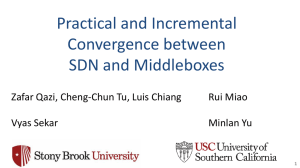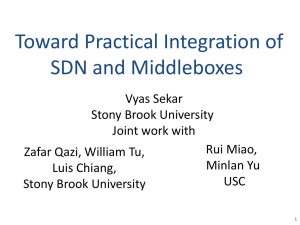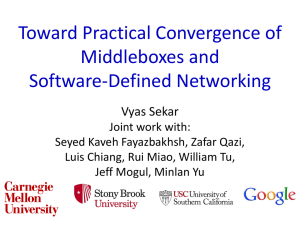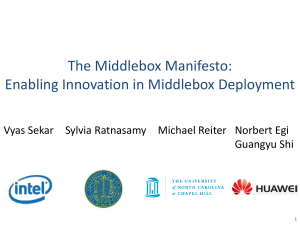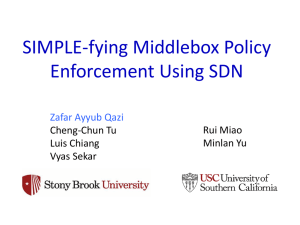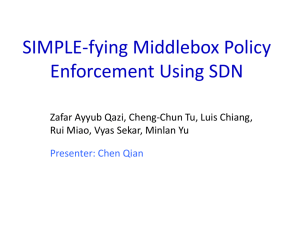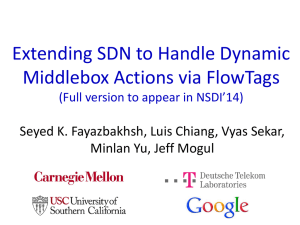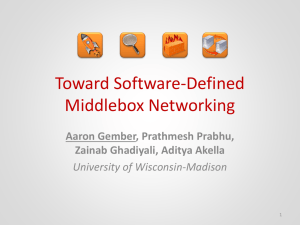SDN Middleboxes - Columbia University
advertisement
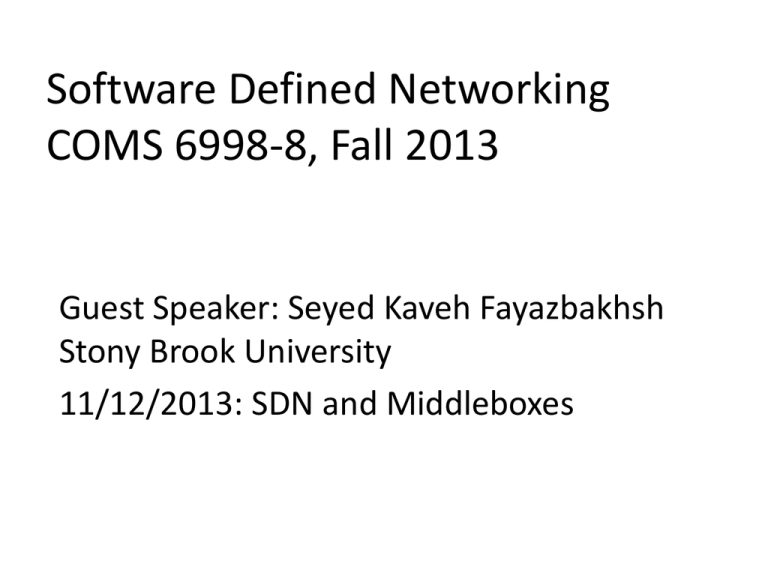
Software Defined Networking COMS 6998-8, Fall 2013 Guest Speaker: Seyed Kaveh Fayazbakhsh Stony Brook University 11/12/2013: SDN and Middleboxes Need for Network Evolution New applications Evolving threats Performance, Security Policy constraints New devices 2 Network Evolution today: Middleboxes! Type of appliance Data from a large enterprise: >80K users across tens of sites Just network security $10 billion Number Firewalls 166 NIDS 127 Media gateways 110 Load balancers 67 Proxies 66 VPN gateways 45 WAN Optimizers 44 Voice gateways 11 Total Middleboxes Total routers 636 ~900 (Sherry et al, SIGCOMM’ 12) 3 There are many middleboxes! Survey across 57 enterprise networks (Sherry et al, SIGCOMM’ 12) 10/22/13 Software Defined Networking (COMS 6998-8) 4 Things to keep in mind about middleboxes • A middlebox is any traffic processing device except for routers and switches. • Why do we need them? – Security – Performance • Deployments of middlebox functionalities: – Embedded in switches and routers (e.g., packet filtering) – Specialized devices with hardware support of SSL acceleration, DPI, etc. – Virtual vs. Physical Appliances – Local (i.e., in-site) vs. Remote (i.e., in-the-cloud) deployments • They can break end-to-end semantics (e.g., load balancing) 10/22/13 Software Defined Networking (COMS 6998-8) 5 SDN Stack Where do middleboxes logically fit in? App Runtime Applications Controller Control Flow, Data Structures, etc. Controller Platform Switch API Switches 6 Outline • Recent trends in middlebox design/deployment – Middlebox Consolidation (CoMb) – Extensible Software Middlebox Architecture (xOMB) • Middleboxes/SDN Integration – Elastic Execution (Split/Merge) – Policy enforcement (SIMPLE) – Handling dynamic traffic modification (FlowTags) 10/22/13 Software Defined Networking (COMS 6998-8) 7 Outline • Recent trends in middlebox design/deployment – Middlebox Consolidation (CoMb) – Extensible Software Middlebox Architecture (xOMB) • Middleboxes/SDN Integration – Elastic Execution (Split/Merge) – Policy enforcement (SIMPLE) – Handling dynamic traffic modification (FlowTags) 10/22/13 Software Defined Networking (COMS 6998-8) 8 Design and Implementation of a Consolidated Middlebox Architecture Vyas Sekar Sylvia Ratnasamy Michael Reiter Norbert Egi Guangyu Shi Ack: Vyas Sekar 9 Key “pain points” Narrow Management Management Management interfaces Specialized boxes “Point” solutions! Increases capital expenses & sprawl Increases operating expenses Limits extensibility and flexibility 10 Key idea: Consolidation Two levels corresponding to two sources of inefficiency Network-wide Controller 2. Consolidate Management 1. Consolidate Platform 11 Consolidation at Platform-Level Today: Independent, specialized boxes Proxy Firewall IDS/IPS AppFilter Decouple Hardware and Software 12 Consolidation reduces CapEx Multiplexing benefit = Sum_of_MaxUtilizations/ Max_of_TotalUtilization 13 Consolidation Enables Extensibility VPN Web Mail IDS Proxy Firewall Protocol Parsers Session Management Contribution of reusable modules: 30 – 80 % 14 Management consolidation enables flexible resource allocation Today: All processing at logical “ingress” Process Process (0.4(P) P) N1 Overload! Process (0.3 P) Process (0.3 P) N2 N3 P: N1 N3 Network-wide distribution reduces load imbalance 15 CoMb System Overview Network-wide Controller Logically centralized e.g., NOX, 4D General-purpose hardware Existing work: simple, homogeneous routing-like workload Middleboxes: complex, heterogeneous, new opportunities 16 CoMb Management Layer Goal: Balance load across network. Leverage multiplexing, reuse, distribution Policy Constraints Resource Requirements Network-wide Controller Routing, Traffic Processing responsibilities 17 Capturing Reuse with HyperApps HyperApp: find the union of apps to run HTTP: 1+2 unit of CPU 1+3 units of mem HTTP UDP IDS 2 1 HTTP = IDS & Proxy HTTP NFS Proxy common CPU 3 4 Memory UDP = IDS 3 1 3 1 Memory CPU Memory CPU NFS = Proxy HTTP Footprint on resource CPU 1 4 Memory Need per-packet policy, reuse dependencies! 18 Modeling Processing Coverage HTTP: Run IDS -> Proxy IDS < Proxy 0.4 IDS < Proxy 0.3 IDS < Proxy 0.3 HTTP N1 N3 N1 N2 N3 What fraction of traffic of class HTTP from N1 N3 should each node process? 19 Network-wide Optimization Minimize Maximum Load, Subject to Processing coverage for each class of traffic Fraction of processed traffic adds up to 1 Load on each node Sum over HyperApp responsibilities per-path No explicit Dependency Policy A simple, tractable linear program Very close (< 0.1%) to theoretical optimal 20 CoMb System Overview Network-wide Controller Logically centralized e.g., NOX, 4D General-purpose hardware Existing work: simple, homogeneous routing-like workload Middleboxes: complex, heterogeneous, new opportunities 21 CoMb Platform Applications Policy Enforcer IDS … Proxy Core1 … Core4 Policy Shim (Pshim) IDS -> Proxy Classification: HTTP NIC Traffic Challenges: Performance Parallelize Isolation Challenges: Lightweight Parallelize Challenges: No contention Fast classification 22 Parallelizing Application Instances App-per-core M1 M2 Core1 Core2 PShim HyperApp-per-core M3 Core3 PShim - Inter-core communication - More work for PShim + No in-core context switch M1 M2 Core1 PShim M2 M3 ✔ Core2 PShim + Keeps structures core-local + Better for reuse - But incurs context-switch - Need replicas HyperApp-per-core is better or comparable Contention does not seem to matter! 23 CoMb Platform Design Core-local processing Core 1 M1 Hyper App1 M2 Workload balancing Core 2 M3 M1 M4 Hyper App2 Hyper App3 PShim PShim PShim Q1 Q2 Q3 NIC hardware Core 3 M5 Hyper App4 PShim Q4 M1 M4 Hyper App3 PShim Q5 Parallel, core-local Contention-free network I/O 24 Benefits: Reduction in Maximum Load MaxLoadToday /MaxLoadConsolidated Consolidation reduces maximum load by 2.5-25X 25 Benefits: Reduction in Provisioning Cost ProvisioningToday /ProvisioningConsolidated Consolidation reduces provisioning cost 1.8-2.5X 26 Outline • Recent trends in middlebox design/deployment – Middlebox Consolidation (CoMb) – Extensible Software Middlebox Architecture (xOMB) • Middleboxes/SDN Integration – Elastic Execution (Split/Merge) – Policy enforcement (SIMPLE) – Handling dynamic traffic modification (FlowTags) 10/22/13 Software Defined Networking (COMS 6998-8) 27 xOMB: Extensible Open Middleboxes with Commodity Servers James Anderson, Ryan Braud, Rishi Kapoor, George Porter and Amin Vahdat Ack: Rishi Kapoor 28 xOMB • CoMb focused on consolidated deployment of middleboxes and simplifying network deployment. • xOMB is a framework for programmable middleboxes using commodity servers. • Provides low-level functionality necessary for high performance processing • User defined functionality on top of basic xOMB blocks 29 xOMB Framework Controller Hardware Switch Client Connections F(N) G(N) F(N) G(N) F(N) LAN G(N) Backend Servers 30 xOMB Architecture xOMB Modules or User Defined Pipeline Basic Functionality Buffer Manager Connection Manager Message Reorder Buffer Socket I/O Client TCP Control Plane Backend TCP 31 Outline • Recent trends in middlebox design/deployment – Middlebox Consolidation (CoMb) – Extensible Software Middlebox Architecture (xOMB) • Middleboxes/SDN Integration – Elastic Execution (Split/Merge) – Policy enforcement (SIMPLE) – Handling dynamic traffic modification (FlowTags) 10/22/13 Software Defined Networking (COMS 6998-8) 32 Split / Merge System Support for Elastic Execution in Virtual Middleboxes Shriram RAJAGOPALAN Dan WILLIAMS Hani JAMJOOM Andrew WARFIELD Ack: Shriram Rajagopalan IBM Research & UBC IBM Research IBM Research UBC Elastic Apps Need Elastic Middleboxes Elastic App Tier Flows IDS/IPS Firewall Clients LB VPN Accelerator SDN Virtual Middleboxes Alleviating Hotspots Elastic App Tier SDN M1 M2 Virtual Middleboxes Solution: When M1 is overloaded, provision more middlebox(es) to serve new flows. Alleviating Hotspots Elastic App Tier SDN M1 M2 M3 M4 Scaling Inefficiencies Lead to Poor Utilization. Virtual Middleboxes Split/Merge Insight Elastic App Tier SDN M1 Flow Table Virtual Middleboxes Split/Merge Insight Elastic App Tier SDN Flow Table Flow Table Virtual Middleboxes Intuition: Dynamic partitioning of flow states among replicas enables elastic execution. t State Inside a Middlebox Middlebox VM Caches Threshold counters Key 5-tuple Other processes … Non-critical statistics Internal to a replica May be shared among replicas (coherent) Flow Table Value [Flow State] Partitionable among replicas Split/Merge: A State-Centric Approach to Elasticity VM Virtual Network Interface Internal Coherent Partitionable (Flow States) Split/Merge: A State-Centric Approach to Elasticity Internal VM Coherent Virtual Network Interface Partitionable (Flow States) Split Replica 1 VM Replica 3 Replica 2 1 VM 2 VM 3 Split/Merge: A State-Centric Approach to Elasticity Internal VM Coherent Virtual Network Interface! Partitionable (Flow States) Split Replica 1 Unchanged Interfaces! VM Replica 2 VM 1 Replica 3 VM 2 Merge Replica 1 VM Replica 2+3 1 VM 2 3 Coherency is maintained Implementation FreeFlow Replica 1 Replica 2 VM VM Internal Coherent Partitionable (Flow States) 1 2 VMM VMM Traffic to Middlebox Flow 1 Flow 2 FreeFlow Replica 1 — Need to manage application state Replica 2 VM VM 1 2 VMM VMM Traffic to Middlebox Flow 1 Flow 2 FreeFlow Replica 1 — Need to manage application state —Need Replica 2 VM VM 1 to ensure flows are routed to the correct replica 2 VMM VMM FreeFlow Module Flow 1 Controller Traffic to Middlebox Flow 2 FreeFlow Replica 1 — Need to manage application state —Need VM VM 1 to ensure flows are routed to the correct replica —Need to decide when to split or merge a replica Replica 2 2 VMM Orchestrator VMM FreeFlow Module Flow 1 Controller Traffic to Middlebox Flow 2 Forwarding Flows Correctly using OpenFlow 1.1.1.1 (de:ad:be:ef:ca:fe) Flow Table <a> OpenFlow Table <a> port 1 port 1 … OpenFlow Table <a> port 1 <b> port 2 <c> port 2 port 1 MBox Replica Middlebox Replica 1 1! 1.1.1.1 (de:ad:be:ef:ca:fe) … OpenFlow Open FlowSwitch! SW Virtual OpenSwitch! Flow SW … OpenFlow Table port 2 <b> port 1 <c> port 1 … Open Flow SW port 1 Virtual Switch! Flow Table <b> <c> … MBox Replica 2 Middlebox Replica 2! Flow Migration 1.1.1.1 (de:ad:be:ef:ca:fe) Flow Table Migrating <b> from replica 2 to replica 1 <a> OpenFlow Table <a> port 1 port 1 … OpenFlow Table <a> port 1 <b> port 2 <c> port 2 port 1 MBox Replica Middlebox Replica 1 1! 1.1.1.1 (de:ad:be:ef:ca:fe) … Open Flow SW Virtual OpenSwitch! Flow SW … OpenFlow Table port 2 <b> port 1 <c> port 1 … Open Flow SW port 1 Virtual Switch! Flow Table <b> <c> … MBox Replica 2 Middlebox Replica 2! Flow Migration 1.1.1.1 (de:ad:be:ef:ca:fe) Flow Table 1. Suspend flow and buffer packets <a> OpenFlow Table <a> port 1 port 1 … OpenFlow Table <a> port 1 <b> controller <c> port 2 port 1 MBox Replica Middlebox Replica 1 1! 1.1.1.1 (de:ad:be:ef:ca:fe) … Open Flow SW Virtual OpenSwitch! Flow SW … OpenFlow Table port 2 <c> Flow Table port 1 …! <b> <c> <c>! Open Flow SW port 1 Virtual Switch! … MBox Replica 2 Middlebox Replica 2! Flow Migration 1.1.1.1 (de:ad:be:ef:ca:fe) 2. Move flow state to target Flow Table <a> OpenFlow Table <a> port 1 port 1 … OpenFlow Table <a> port 1 <b> controller <c> port 2 port 1 … MBox Replica Middlebox Replica 1 1! 1.1.1.1 (de:ad:be:ef:ca:fe) … Open Flow SW Virtual Switch! Open Flow SW <b> OpenFlow Table! port 2 <c> Flow Table! port 1 … <c <c> Virtual Switch! Open Flow SW port 1! … MBox Replica 2 Middlebox Replica 2! Flow Migration 1.1.1.1 (de:ad:be:ef:ca:fe) 3. Release buffer and resume flow Flow Table <a> port 1 <b> port 1 OpenFlow Table <a> port 1 <b> port 1 <c> port 2 <a> OpenFlow Table port 1 … port 1 … OpenFlow Switch! Open Flow SW port 2 Virtual Switch! Open Flow SW <b> … MBox Replica Middlebox Replica 1 1! 1.1.1.1 (de:ad:be:ef:ca:fe) OpenFlow Table <c> Flow Table port 1 … <c> Virtual Switch! Open Flow SW port 1 .. MBox Replica 2 Middlebox Replica 2! Managing Coherent State create_shared(key, size, cb) delete_shared(key) state get_shared(key, flags) // synch | pull |local put_shared(key, flags) // synch | push |local Managing Coherent State Strong Consistency create_shared(“foo”, 4, NULL) while (1) process_packet() p_foo Distributed lock for every update = get_shared(“foo”, synch) val = (*p_foo)++ put_shared(“foo”, synch) if (val > threshold) bar() Middlebox applications rarely need strong consistency! Managing Coherent State Eventual Consistency create_shared(“foo”, 4, merge_fn) while (1) process_packet() p_foo = get_shared(“foo”, local) Hi frequency local updates Periodic global updates val = (*p_foo)++ put_shared(“foo”, local) if (val > threshold) bar() put_shared(“foo”, push) Eliminating Hotspots by Shedding Load Eliminating Hotspots by Shedding Load Outline • Recent trends in middlebox design/deployment – Middlebox Consolidation (CoMb) – Extensible Software Middlebox Architecture (xOMB) • Middleboxes/SDN Integration – Elastic Execution (Split/Merge) – Policy enforcement (SIMPLE) – Handling dynamic traffic modification (FlowTags) 10/22/13 Software Defined Networking (COMS 6998-8) 59 SIMPLE-fying Middlebox Policy Enforcement Using SDN Zafar Ayyub Qazi Cheng-Chun Tu Luis Chiang Vyas Sekar Rui Miao Minlan Yu Can SDN simplify middlebox management? Centralized Controller Web Firewall IDS Proxy “Flow” FwdAction … … Proxy OpenFlow “Flow” FwdAction … … IDS Scope: Enforce middlebox-specific steering policies Necessity + Opportunity: Incorporate functions markets views as important 61 What makes this problem challenging? Centralized Controller Web Firewall IDS Proxy “Flow” FwdAction … … Proxy OpenFlow “Flow” FwdAction … … IDS Middleboxes introduce new dimensions beyond L2/L3 tasks. Achieve this with unmodified middleboxes and existing SDN APIs 62 Our Work: SIMPLE Web Firewall IDS Proxy Policy enforcement layer for middlebox-specific “traffic steering” Legacy Middleboxes Flow Action … … Flow Action … … OpenFlow capable 63 Challenge: Policy Composition Policy Chain: Firewall S1 * IDS Proxy Firewall IDS Proxy Oops! Forward Pkt to IDS or Dst? S2 Dst “Loops” Traditional flow rules may not suffice! 64 Challenge: Resource Constraints Firewall Proxy Space for traffic split? S2 S1 S3 S4 IDS1 = 50% IDS2 = 50% Can we set up “feasible” forwarding rules? 65 Challenge: Dynamic Modifications User1: Proxy Firewall User2: Proxy User 1 Proxy S1 User 2 Proxy may modify flows S2 Firewall Are forwarding rules at S2 correct? 66 SIMPLE System Overview Web Firewall IDS Proxy Modifications Handler Resource Manager Rule Generator Legacy Middleboxes Flow Action … … Flow Action … … OpenFlow capable 67 Composition Tag Processing State Policy Chain: Firewall * Firewall IDS Proxy IDS Proxy Fwd to Dst S1 ORIGINAL S2 Dst Post-Firewall Post-Proxy Post-IDS Insight: Distinguish different instances of the same packet 68 SIMPLE System Overview Web Firewall IDS Proxy Modifications Handler Resource Manager Rule Generator Legacy Middleboxes Flow Action … … Flow Action … … OpenFlow capable 69 Resource Constraints Joint Optimization Topology & Traffic Middlebox Capacity + Footprints Switch TCAM Policy Spec Resource Manager Optimal & Feasible load balancing Theoretically hard! Not obvious if some configuration is feasible! 70 Offline + Online Decomposition Policy Spec Network Topology Switch TCAM Mbox Capacity + Footprints Traffic Matrix Resource Manager Offline Stage Deals with Switch constraints Online Step Deals with only load balancing 71 SIMPLE System Overview Web FW IDS Proxy Modifications Handler Resource Manager Rule Generator Legacy Middleboxes Flow Action … … Flow Action … … OpenFlow capable 72 Modifications Infer flow correlations Correlate flows Install rules Payload Similarity Proxy User 1 S1 User 2 S2 Firewall User1: Proxy Firewall User2: Proxy 73 SIMPLE Implementation Web Resource Manager (Resource Constraint) FW IDS Proxy Modifications Handler (Dynamic modifications) CPLEX Rule Generator (Policy Composition) POX extensions OpenFlow 1.0 Flow … Tag/Tun nel Action … Flow … Tag/Tun nel Action … 74 Evaluation and Methodology • • • • • What benefits SIMPLE offers? load balancing? How scalable is the SIMPLE optimizer? How close is the SIMPLE optimizer to the optimal? How accurate is the dynamic inference? Methodology – Small-scale real test bed experiments (Emulab) – Evaluation over Mininet (with up to 60 nodes) – Large-scale trace driven simulations (for convergence times) 75 Benefits: Load balancing Optimal 4-7X better load balancing and near optimal 76 Outline • Recent trends in middlebox design/deployment – Middlebox Consolidation (CoMb) – Extensible Software Middlebox Architecture (xOMB) • Middleboxes/SDN Integration – Elastic Execution (Split/Merge) – Policy enforcement (SIMPLE) – Handling dynamic traffic modification (FlowTags) 10/22/13 Software Defined Networking (COMS 6998-8) 77 FlowTags: Enforcing Network-Wide Policies in the Presence of Dynamic Middlebox Actions Seyed K. Fayazbakhsh Vyas Sekar Minlan Yu Jeff Mogul 78 Middleboxes complicate policy enforcement in SDN Policy routing Access control Diagnostics Forensics Admin Logical view: Specify policy goals Control Apps Physical View Network OS Dynamic traffic-dependent modifications! e.g., NATs, proxies Data Plane “Flow” Action … … 79 Example: Policy Routing H1: NAT Firewall H2: NAT IDS NAT IDS Firewall H1 Internet H2 S1 S2 How do we setup correct forwarding rules? 80 Example: Dynamic Dependence Proxy H1 Web ACL: Block H2 xyz Cached response Internet H2 S1 S2 Cached responses may violate policy 81 Strawman Solutions • Careful placement? (i.e., manual) – May not always be feasible • Consolidating middleboxes? (e.g., CoMb) – Just “punting” the problem • Inferring flow mappings? (e.g., SIMPLE) – Hard to reason about accuracy + high overhead Key missing piece: Lack of “visibility” into middlebox context 82 FlowTags: High-level Idea • Middleboxes “help” with the lack of visibility • Add FlowTags to packets to bridge gaps – NAT gives IP mappings; Proxy gives cache hit/miss • Middleboxes “produce” + “consume” FlowTags • Switches only “consume” FlowTags 83 FlowTags Architecture Overview Control Apps Existing Interfaces e.g., OpenFlow SDN FlowTable enabled Switches Controller FlowTags API “decouple” FlowTags Config FlowTags Enhanced Middleboxes e.g., NAT exposes mappings Proxy gives hit/miss state IDS uses tags to disambiguate 84 Policy Implementation via FlowTags Policy: Block H2 xyz TagsFlowTable TagsActionTable H1, MISS 1 H1, HIT 2 H2, MISS 3 H2, HIT 4 H1 Tag Src 4 H2 Proxy ACL S1 H2 Input Proxy Proxy Tag Out 2 H1 1,3,4 S2 Action Block S2 Internet Input S1 ACL ACL Tag 1,3,4 4 1,3 Out ACL S1 Internet 85 FlowTags Proof-of-Concept • Using Squid (> over 100,000 lines of code) • About 30 lines of code to add FlowTags support – Manually identify code chokepoints • Validated use-cases with examples 86
